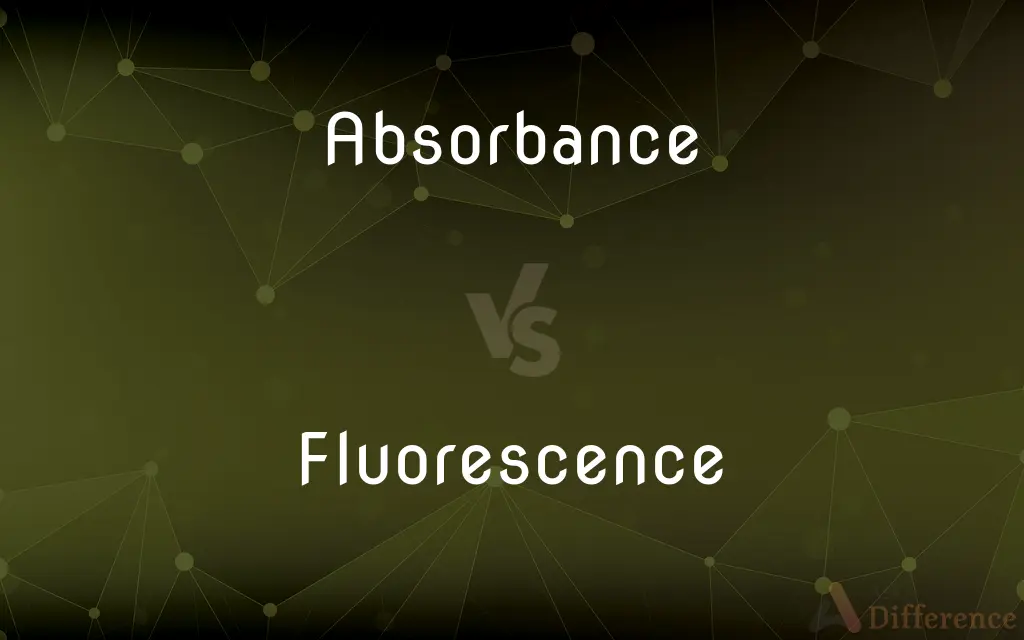Absorbance vs. Fluorescence — What's the Difference?
By Tayyaba Rehman — Published on November 28, 2023
Absorbance measures the amount of light absorbed by a material, while fluorescence involves absorbing light at one wavelength and re-emitting it at another.

Difference Between Absorbance and Fluorescence
Table of Contents
ADVERTISEMENT
Key Differences
Absorbance and fluorescence represent crucial concepts in optical spectroscopy, serving diverse purposes in scientific research and applications. Absorbance involves the quantification of the amount of light absorbed when it passes through a material. Essentially, absorbance provides insights into the concentration of a light-absorbing compound in a sample, offering crucial data in numerous scientific fields, particularly in studying chemical concentrations.
Contrastingly, fluorescence is a phenomenon where a molecule absorbs light or photons, becomes excited, and then emits light at a longer wavelength. Therefore, fluorescence provides details about the properties of the substance, such as its environment and concentration, especially useful in biological, biochemical, and medical research. It can visualize and quantify biological processes.
In the application of absorbance, one frequently encounters its utilization in techniques like UV-Visible Spectroscopy, where light absorption helps determine a solute's concentration within a solvent. Absorbance holds paramount importance in analytic chemistry and biology, facilitating evaluations of chemical and biological reactions, often using Beer-Lambert's law to relate absorbance, path length, and concentration of the analyte.
Fluorescence, with its root in absorbing and re-emitting light, plays a critical role in numerous applications like fluorescence microscopy and fluorometry. These applications harness fluorescence to explore biological entities, visualize biological or biochemical processes, and also to scrutinize materials in physics and chemistry. Fluorescence microscopy, for example, uses the fluorescence principle to create high-contrast images of microscopic objects.
While absorbance typically does not involve changing the wavelength of light, simply measuring the reduction in intensity, fluorescence fundamentally encompasses the shift in wavelength, from the excitation wavelength to the emission wavelength. This makes fluorescence notably suitable for studies requiring differentiation between the excitation light and emitted light, thereby elucidating diverse properties and interactions of substances.
ADVERTISEMENT
In certain applications, such as biochemical assays or molecular biology, both absorbance and fluorescence can be applied, albeit with different intents and outcomes. Absorbance might quantify nucleic acids or proteins, while fluorescence, through fluorescent tagging, can visualize, track, and quantify biological molecules, paving the way for exploring biological pathways and interactions with refined precision and detail.
Comparison Chart
Basic Definition
Light absorption measurement
Light absorption and re-emission phenomenon
Wavelength Change
No
Yes, from excitation to emission
Typical Applications
Concentration determination
Imaging, tracking, and quantifying molecules
Use in Spectroscopy
UV-Visible Spectroscopy
Fluorescence Spectroscopy
Instrumentation Example
Spectrophotometer
Fluorometer, Fluorescence Microscope
Compare with Definitions
Absorbance
Indicator of a material’s opaqueness.
Opaque materials typically exhibit high absorbance.
Fluorescence
Emission of light post-absorption.
The material exhibited fluorescence under UV light.
Absorbance
Inverse log of transmitted light ratio.
Absorbance quantifies light loss through a medium.
Fluorescence
Phenomenon of photoluminescence.
Fluorophores are molecules known for their fluorescence.
Absorbance
Proportional to absorber concentration.
Beer's Law relates absorbance to solute concentration.
Fluorescence
Re-emission at a longer wavelength.
The fluorescence emitted was visible in the green spectrum.
Absorbance
Quantification of absorbed light.
The spectrophotometer revealed a high absorbance.
Fluorescence
Observable in various substances.
Some minerals display fluorescence under specific lighting.
Absorbance
A measure of light absorption.
The sample’s absorbance increased with concentration.
Fluorescence
The emission of electromagnetic radiation, especially of visible light, stimulated in a substance by the absorption of incident radiation and persisting only as long as the stimulating radiation is continued.
Absorbance
(physics) A logarithmic measure of the amount of light that is absorbed when passing through a substance; the capacity of a substance to absorb light of a given wavelength; optical density.
Fluorescence
The property of emitting such radiation.
Fluorescence
The radiation so emitted.
Fluorescence
(physics) The emission of light (or other electromagnetic radiation) by a material when stimulated by the absorption of radiation or of a subatomic particle.
Fluorescence
The light so emitted.
Fluorescence
A luminescence emitted by certain substances due to the absorption of radiation at one wavelength, and the almost instantaneous re-emission of radiation at another, usually longer wavelength. The re-radiation stops almost as soon as the incident radiation is halted, thus distinguishing this phenomenon from phosphorescence, in which re-radiation of light may continue for some time after the incident radiation is halted.
Fluorescence
Light emitted during absorption of radiation of some other (invisible) wavelength
Fluorescence
Utilized in biological imaging.
Fluorescence microscopy allows detailed cellular exploration.
Common Curiosities
What is absorbance used for in chemistry?
It's commonly used to determine the concentration of a specific substance in a solution.
Is high absorbance always desired?
Not necessarily; it depends on the application and the sample being studied.
Does fluorescence require a special light source?
Yes, specific excitation wavelengths are needed to induce fluorescence in molecules.
How is fluorescence intensity quantified?
It is often quantified using instruments like fluorometers or spectrofluorometers.
Does absorbance alter light wavelength?
No, absorbance measures light loss without changing its wavelength.
What makes a molecule fluorescent?
A molecule's electron configuration and its ability to absorb and re-emit light cause fluorescence.
In what applications is fluorescence utilized?
Fluorescence is used in microscopy, bioimaging, and analytical techniques like fluorometry.
Can both absorbance and fluorescence be measured simultaneously?
Yes, some instruments, like spectrophotofluorometers, can measure both sequentially.
What factors influence absorbance readings?
Concentration, path length, and the light source’s intensity influence absorbance.
Does fluorescence always emit light at a longer wavelength?
Yes, fluorescence involves emission at a longer wavelength than absorption.
Can we calculate concentration using absorbance?
Yes, through Beer-Lambert Law: A = εlc, where A is absorbance, ε is molar absorptivity, l is path length, and c is concentration.
Can fluorescence be quenched?
Yes, certain substances or conditions can quench (diminish) fluorescence.
Can all compounds show fluorescence?
No, only those with specific electronic configurations (fluorophores) exhibit fluorescence.
Are there limitations to using fluorescence in research?
Yes, factors like fluorophore stability, sensitivity to environment, and photobleaching may pose limitations.
How does temperature affect absorbance?
Temperature can affect the absorption characteristics of some compounds.
Share Your Discovery

Previous Comparison
Classic Fit vs. Custom Fit
Next Comparison
Critical Point vs. Triple PointAuthor Spotlight
Written by
Tayyaba RehmanTayyaba Rehman is a distinguished writer, currently serving as a primary contributor to askdifference.com. As a researcher in semantics and etymology, Tayyaba's passion for the complexity of languages and their distinctions has found a perfect home on the platform. Tayyaba delves into the intricacies of language, distinguishing between commonly confused words and phrases, thereby providing clarity for readers worldwide.













































